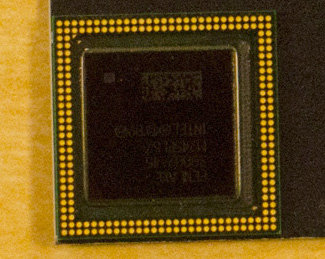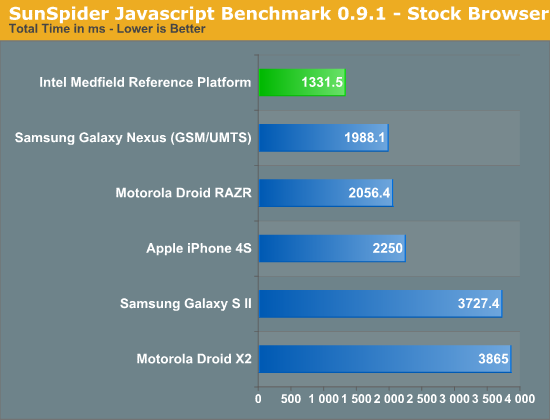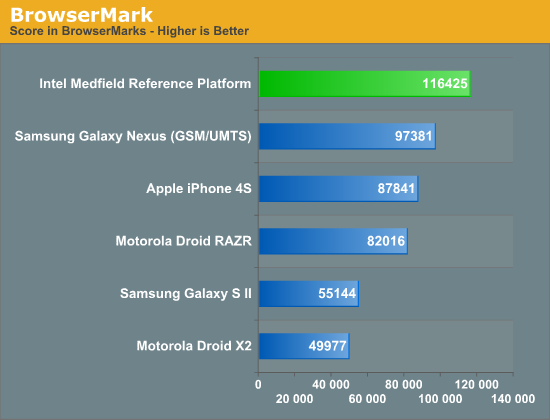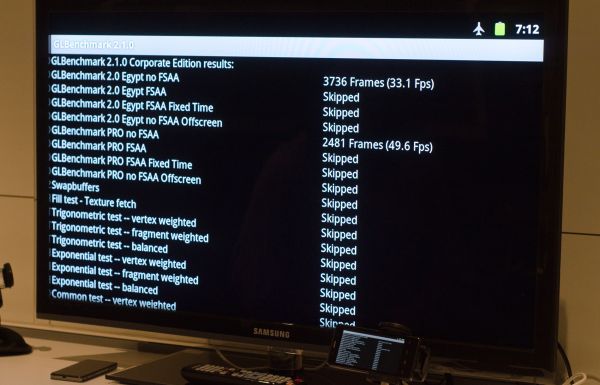Intel's Medfield & Atom Z2460 Arrive for Smartphones: It's Finally Here
by Anand Lal Shimpi on January 10, 2012 8:00 PM ESTIt's here. Intel's first smartphone SoC that you'll actually be able to buy in a device before the end of the year. The platform is called Medfield and Paul Otellini just announced its first device partners.
Medfield starts out as a bonafide mobile SoC. Whereas Moorestown was a "two-chip" solution, Medfield is just one - the Penwell SoC:

The SoC is only available in a PoP (Package on Package) configuration measuring 12mm x 12mm. Intel wouldn't give out a die size but it did show me a Penwell sample without the stacked DRAM:

Since I know the measurements of the package I could estimate the dimensions of the silicon itself. My math worked out to be around 62mm^2. That's larger than a Tegra 2-class SoC, but smaller than Tegra 3 or Apple's A5. The diagram of its high level architecture above helps explain why.
There's only a single version of Medfield being announced today: the Intel Atom Z2460. The Z2460 features a single Atom core with a 512KB L2 cache, a PowerVR SGX 540 GPU and a dual-channel LPDDR2 memory interface. In a world where talking about four Cortex A9s and PowerVR SGX 544MP2s isn't uncommon, Medfield starts out almost sounding a bit...tame. But then you see its performance:

Although running what appears to be a stock Gingerbread browser, Intel's Medfield reference platform posts SunSpider performance better than any other smartphone we've tested - including the Galaxy Nexus running Ice Cream Sandwich. Intel promises that Medfield's performance will scale on ICS as well - the gap should be maintained. We've seen high results from reference designs in the past, but the Medfield platform is a little different as you'll soon see - it's a complete smartphone design that should be representative of handsets that hit the market later this year.
Medfield isn't a one trick pony either, performance is similarly dominating under BrowserMark:

These are tablet-like scores. Here the Galaxy Nexus running ICS comes close, but once again Intel expects that on the same OS Medfield should be faster than any of the currently available SoCs.
I asked Intel where its SunSpider and BrowserMark performance advantages came from, especially considering we've typically only seen huge gains with new browsers and not new SoCs. Their response pointed to a bunch of factors, but one stand out issue was the A9 has a great execution core but seems to be more limited on the memory interface. Atom can support far more outstanding misses in L2 than the Cortex A9, which chokes bandwidth to the processor for anything not already in the L2 cache. This may be one of the reasons why we've never been able to get really high bandwidth numbers out of A9 based SoCs. It's probably safe to assume that things will be different with the Cortex A15, but for now it's little things like this that give Medfield a performance advantage.
GPU performance is understandably not as impressive. We couldn't get offscreen numbers of GLBenchmark 2.1 but we did get results at the device's native resolution (1024 x 600):
3D performance is better than the OMAP 4460 due to Medfield's 400MHz GPU clock compared to ~300MHz in most OMAP4 devices.
Performance without power considerations is meaningless, especially in the smartphone world. Luckily for Intel, Medfield seems very competitive there as well. Intel provided some power and performance data for Medfield based on its reference platform. I still haven't been able to verify any of this for myself, but I was able to see some power tests run in person on the reference platform and competitive devices.
The Intel provided values are pretty astonishing . Sub 20mW idle, sub 750mW during a call on 3G and although not pictured here, Intel's internal data suggests ~1W power consumption while browsing the web compared to ~1.3W on the iPhone 4S and Galaxy S 2. I've done my own measurements on 4S web browsing and came up with a very similar value.
| Intel Measured Smartphone Power Consumption (Identical Display Brightness) | ||||||
| Standby (3G) | Talk (3G) | Browsing (3G) | Video Playback 720p | |||
| Apple iPhone 4S | ~38mW | ~800mW | ~1.3W | ~500mW | ||
| Intel Medfield Reference | ~18mW | ~700mW | ~1.0W | ~850mW | ||
| Samsung Galaxy S II | ~19mW | ~675mW | ~1.2W | ~650mW | ||
The performance and power data both look great for Medfield. You would think that this data, assuming there's nothing fundamentally wrong, would be enough to convince a handset maker to actually give Intel a shot. You'd be right.
In addition to disclosing Medfield performance data, Intel is also announcing partnerships with both Motorola and Lenovo. The former is a broad, multi-year agreement stating that Motorola plans on creating many devices based on Intel silicon - the first of which will be a smartphone due out before the end of the year. Tablets will follow at some point as well.
Lenovo on the other hand will actually be taking and tweaking Intel's own Medfield reference platform, and releasing it in China in Q2.
All of this is exactly what Intel needed: a start.











164 Comments
View All Comments
mrtanner70 - Wednesday, January 11, 2012 - link
I am a long time fan of the site and still think your actual product testing is the best. However over the last year or so there has been a noticeable pattern of really being a bit too enthusiastic toward Intel PR and spin. I would like to see a little bit more intelligent skepticism when dealing with Intel reference designs and slide decks.Lucian Armasu - Thursday, January 12, 2012 - link
I have to agree, about Intel spinning stuff more and more lately, too. I've noticed it since they announced the "3D" chips. Everyone reacted as if the 3D are 10x better than SNB or whatever, when in fact that's not true. The 3D chips have only +37% performance at the same power level, OR -50% power consumption at the same performance level. That's barely as news worthy as they made it sound. They put 1 extra year ahead of AMD at most on top of the 6 months difference they already have now.So I don't know how everyone got from that that now that they have that they will be able to compete with ARM, which ARM at the same performance has much better power efficiency and also costs several times less.
Hector2 - Thursday, January 12, 2012 - link
What you said is about right for "active" power. A couple of things not mentioned is that the 22nm chip will be quite a bit smaller than 32nm (meaning even lower cost) and that the FinFET transistors drop the "standby" power by a factor of 10X-20X lower than even the 32nm version.As was said somewhere, Medfield gets Intel's foot in the door with a competitive product --- and I think most here will agree that it's at least competitive. Certainly, Intel's new partners must think so. The coming of the 22nm upgrade in 2013 is where it really gets interesting.
It's taken Intel awhile to carve out a viable single chip design that's product-worthy. Now that they have one, I expect them to march with the same tick-tock cadence that they've driven the PC market with -- and they already have working 3D FinFET 14nm chips in the lab.
Finally - Thursday, January 12, 2012 - link
Mark my words:The day that AnandTech welcomes a revolutionary AMD product (think e.g. Brazos II) with the words "It's finally here" will be the very day hell freezes over.
Hector2 - Thursday, January 19, 2012 - link
Hmmm. When do you think AMD might be entering the smartphone market ?thunng8 - Wednesday, January 11, 2012 - link
That intel graph for graphics performance is way off and misleading.If one of the smartphones tested is the iphone4S, then that phone should have >2x performance advantage in graphics compared to Medfield reference platform.
solipsism - Wednesday, January 11, 2012 - link
If Medfield is as good as it looks today and they can keep moving along as Cortex-A15 comes along tablets and smartphones could be Intel-based and Apple could be serious trouble by supporting ARM. It could be the whole the PPC issue all over again where Apple will linger for way too long before switching architectures. That's a worse scenario perfect storm, of course, and a long ways off, but it's still something that can't be good for companies with vertical integration with heavy ARM support.markit - Wednesday, January 11, 2012 - link
as infact 2 year old cortex a-9 (even if single cored) outperform it / mhze.g. if i scale down medfields results linearly
(which is imho quite accurate for this benches)
i get:
@1ghz
2130ms and 72766 points
and compare against my old tegra 2 based toshiba ac100 (running ubuntu and chrome 13)
with one core running @ 1 Ghz, and second core turned off i get:
sunspider 1962ms ( per mhz 9% faster)
browsermark 111872 ( per mhz 54% faster as medfield)
so regarding browsermark infact the ac100 nearly matched the 1.6ghz results of this medfield reference plattform while running on only one 1 ghz core,..
btw. both cores turned on and @ 1Ghz:
sunspider 1941 ms
browsermark 114523
so hmm, i think i can guess why intel didn`t choose dual-core friendly benchmarks,..
and remeber the ac100 did hit the stores June 2010!
FunBunny2 - Wednesday, January 11, 2012 - link
I still am puzzled by this. It's been at least a decade since an Intel chip executed X86 code in hardware; the chip is a RISC design fronted by an emulator. Or has Intel gone back to X86 instructions in hardware for these SoC?dealcorn - Thursday, January 12, 2012 - link
Was I deceived? I read about fin-fet and 3d transistors and was impressed because it is credible technology that will permit Intel to do good things before others. That colored my perspective on mobile Atom leading to statements such as "Show time starts at 22 nm." I felt that absent the 3d benefits, Intel would find it tough to go head to head against ARM. While Intel focused attention on 3d, the implication was they are dead in the water until 22nm arrives.That is wrong. Mobile Atom is never going to be built using 22nm transistors. It will be built using 22nm LP transistors. Furthermore, it appears that 32nm LP transistor get the job done just fine (even if 32 nm is worthless in this context). Is 32nm LP the secret sauce that lets it all work? Should the headline have been "Intel's process advantage muscle works almost as good at 32 nm LP as it was supposed to work at 22nm."?